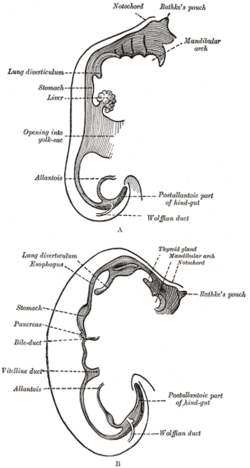Omphalomesenteric duct
| Vitelline duct | |
|---|---|

|
|

Sketches in profile of two stages in the development of the human digestive tube. (Vitelline duct labeled on bottom image.)
|
|
| Details | |
| Days | 28 |
| Precursor | midgut, yolk sac |
| Identifiers | |
| Latin | ductus vitellinus |
| MeSH | A16.254.891 |
|
Anatomical terminology
[]
|
|
In the human embryo, the vitelline duct, also known as the omphalomesenteric duct, is a long narrow tube that joins the yolk sac to the midgut lumen of the developing fetus. It appears at the end of the fourth week, when the yolk sac presents the appearance of a small pear-shaped vesicle (the umbilical vesicle).
Generally, the duct fully obliterates (narrows and disappears) during the 5–6th week of fertilization age (9th week of gestational age), but a failure of the duct to close is termed a vitelline fistula. This results in discharge of meconium from the umbilicus. About two percent of fetuses exhibit a type of vitelline fistula characterized by persistence of the proximal part of the vitelline duct as a diverticulum protruding from the small intestine, Meckel's diverticulum, which is situated about two inches above the ileocecal junction and may be attached by a fibrous cord to the abdominal wall at the umbilicus.
The vesicle can be seen in the afterbirth as a small, somewhat oval-shaped body, the diameter of which varies from 1 mm to 5 mm. It is situated between the amnion and the chorion and may lie on or at a varying distance from the placenta.
Sometimes a narrowing of the lumen of the ileum is seen opposite the site of attachment of the duct. On this site of attachment, sometimes a pathological Meckel's diverticulum may be present.
...
Wikipedia
